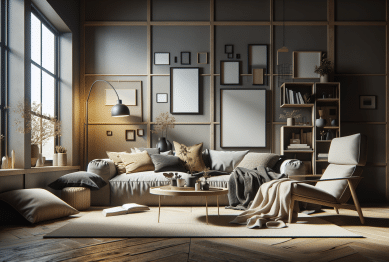Unlock the secrets behind minimalist decor and learn why so many people are transforming their spaces with this impactful trend. Discover tips on decluttering, furniture selection, and design principles that encourage serenity while keeping your living environment both practical and inspiring.
The Essence of Minimalist Decor in Everyday Life
Minimalist decor has risen in popularity, drawing attention from lifestyle enthusiasts and interior designers searching for serene, clutter-free environments. The essence of minimalism lies in simplicity, focusing on function while stripping away unnecessary items and distractions. Many people are attracted to the concept because it offers a sense of control, calm, and clarity within living spaces. Adopting a minimalist mindset means carefully considering every object and maintaining only those that serve a true purpose or spark joy. This approach supports mental wellness by minimizing visual clutter and encouraging intentional living, making the home a sanctuary from the chaos of daily schedules.
A crucial step in embracing minimalist decor involves analyzing the flow of a space. Open layouts are favored, as they allow energy to travel freely and increase a sense of spaciousness even in smaller rooms. Neutral color palettes are often chosen to enhance natural light and create an inviting atmosphere that feels both warm and breathable. Homeowners can find inspiration from Scandinavian designs or Japanese aesthetics that prioritize quality over quantity and invest in versatile pieces that can serve multiple functions. This strategy helps in maintaining a balance between comfort and style, offering an elegant yet unpretentious backdrop for daily living.
Minimalism doesn’t mean bare or boring. Instead, it invites creativity and a thoughtful approach to personalization. Through carefully curated wall art, a single statement piece of decor, or the presence of living plants, rooms can reflect unique personalities without overwhelming the senses. These simple touches bring subtle warmth and character, further reinforcing a sense of tranquility in the home. For those craving a lifestyle that harmonizes beauty and practicality, minimalism provides a refreshing alternative to maximalist trends, supporting a healthier and more intentional way of living.
Decluttering Strategies for a Minimalist Lifestyle
Decluttering forms the core of minimalist decor. The process isn’t just about removing excess objects; it’s about making deliberate choices that align with personal values. One recommended strategy involves segmenting your possessions into categories—keep, donate, recycle, or discard. This method provides clarity and can ease decision fatigue, helping people recognize what truly matters. By frequently decluttering, individuals foster mindful consumption habits and avoid accumulating unnecessary items that often lead to stress or feelings of overwhelm. Over time, the act of letting go turns into a liberating experience, revealing both emotional and physical space within the home.
Many find that starting with one room or area at a time prevents the process from feeling daunting. Kitchens, bathrooms, and closets are particularly impactful zones to tackle. Removing outdated pantry items, expired toiletries, or unworn clothes can yield immediate results and a tangible sense of achievement. Some use the one-in, one-out rule, where bringing in a new item means letting go of an old one. This ongoing system acts as a guardrail against clutter, ensuring long-term adherence to minimalist principles. Digital decluttering, such as organizing files and photos, further extends these benefits, cleansing spaces both physically and virtually.
Decluttering enhances more than aesthetics; it has demonstrable links to mental well-being and productivity. Studies point to connections between clean environments and reduced stress hormones, as well as improved focus and satisfaction with daily life. Beyond the psychological perks, simplified surroundings can streamline cleaning routines and reduce time spent maintaining order. By adopting these proven strategies and practicing regular assessment of household contents, anyone can move steadily toward a sustainable minimalist lifestyle that aligns beautifully with both practical needs and personal aspirations.
Optimizing Furniture and Layout for Minimalism
Selecting the right furniture pieces is key to bringing minimalist decor to life. Multi-functional items, such as nesting tables or sofas with storage, maximize utility while preserving the open feel of a room. Clean lines and understated designs allow for versatility and adaptability across changing trends. Prioritizing fewer but higher-quality pieces ensures durability and creates an atmosphere that’s welcoming without being overcrowded. Every item should serve a clear function or contribute to the overall composition of the space, with emphasis on space-saving and timeless aesthetics.
Arranging furniture intentionally enhances both flow and comfort. Placing sofas to frame a view or setting dining tables near windows invites natural light and frames spaces for social connection. Rather than filling every wall, minimalists often leave gaps to let rooms “breathe,” which can make them appear larger than they are. Floating shelves and wall-mounted fixtures are favored for their ability to save floor space while providing necessary storage or display. Ensuring that there’s ample walkway space further contributes to an uncluttered, tranquil environment that promotes easy movement and relaxation.
Every furniture decision can impact energy, mood, and activity levels within a home. Ergonomic seating supports mental focus and physical health, while foldable or stackable chairs are practical for accommodating guests without permanent loss of space. Minimalism champions design choices that encourage meaningful engagement—whether it’s a cozy reading nook, an inviting meditation spot, or an elegant dinner setting. Ultimately, effective furniture selection and layout empower residents to take full advantage of their spaces in ways tailored to their individual needs and routines.
Color Schemes and Materials in Minimalist Interiors
The palette of minimalist interiors is as vital as the objects within them. Neutral shades—such as whites, grays, creams, or subtle earth tones—form the backbone of minimalist decor and help to visually expand any space. These hues provide a muted backdrop that enhances natural sunlight and creates a gentle, welcoming atmosphere. Color can still play a role, but is often used as a subtle accent through accessories, artwork, or small furnishing details. The key is restraint—avoiding visual clutter or distraction by limiting bold patterns or saturated colors.
Material selection further supports the minimalist ethos. Natural materials like wood, stone, wool, or linen add warmth, texture, and tactile appeal without overwhelming the senses. Incorporating handcrafted elements, such as ceramic vases or woven baskets, introduces organic beauty and elevates the authenticity of the environment. Smooth, reflective surfaces such as glass or polished concrete amplify light, while matte finishes offer softness and tranquility. The conscious juxtaposition of a few diverse textures helps prevent monotony, making the overall design harmonious and interesting.
Minimalist decor encourages mindfulness with every material choice. Sustainable, eco-friendly products align with both environmental values and aesthetic goals, ensuring that homes remain both appealing and responsible. When paired with open floor plans and simplified ornamentation, these color and material decisions reinforce a balanced, peaceful retreat. Choosing finishes that require little maintenance supports everyday practicality, solidifying minimalism as a lifestyle rooted in both beauty and function.
Art, Accents, and Greenery for Inviting Minimalist Spaces
Contrary to the misconception that minimal interiors are impersonal, accent pieces hold significant value. Art selections, such as a bold painting or a monochrome photograph, anchor rooms without overwhelming them. The secret lies in thoughtful curation—displaying a few cherished pieces for impact rather than filling blank walls indiscriminately. Varying scale, frame style, or placement draws attention to specific focal points and supports the overall ambiance without creating visual noise.
Textiles and decor can provide both comfort and dimension. Area rugs in neutral colors, textured throws, or minimalist lighting fixtures evoke warmth without cluttering. Even practical accents like books, unadorned candles, or sculptural lamps convey personality and foster a sense of belonging. Swapping seasonal linens and decor items is an easy, non-permanent way to refresh a room while sticking to minimalist values. Minimalism doesn’t ignore style; it refines it, helping people express individuality through purposefully chosen objects.
Greenery breathes life into minimalist interiors. Houseplants, whether large and leafy or sculptural and spiky, improve air quality while offering a tranquil, natural accent. A single potted statement plant, such as a fiddle-leaf fig or snake plant, can anchor an empty corner with vibrancy and energy. Minimalists often opt for low-maintenance varieties that thrive in indirect light, keeping upkeep easy and consistent with the broader philosophy of simplicity and grace.
Sustaining Minimalist Habits for Long-Term Impact
Maintaining a minimalist home goes beyond an initial decluttering spree. It requires ongoing habits and mindful consumption patterns. Regularly reviewing belongings helps prevent the slow return of excess. Many embrace rituals like seasonal closet assessments or bi-annual household audits to keep possessions aligned with actual needs. Practicing gratitude for what you own fosters contentment and diminishes the desire for constant acquisition. This routine shapes a home life that continues to reflect calm and consideration, year after year.
Mindfulness in shopping is vital. Taking time to research before buying, asking whether an item fills a real gap, and resisting impulse purchases ensures that every new addition has a defined place. Sharing surplus items with others, through donation or recycling, not only supports the community but reinforces the minimalist value of intentional generosity. Technology can be a helpful ally too; digital lists, reminders, and organizational tools support routines and track progress toward ongoing simplicity goals.
Long-term adoption of minimalist habits can influence emotional resilience and environmental consciousness. Homeowners often report increased satisfaction, reduced anxiety, and better focus after removing unnecessary distractions from daily life. These outcomes ripple into other life aspects, from work to relationships, underscoring the holistic benefits of minimalist decor. By remaining committed to these habits, residents not only sustain beautiful homes but also nurture lasting well-being and peace of mind.
References
1. U.S. General Services Administration. (n.d.). The Power of Minimalism in Interior Design. Retrieved from https://www.gsa.gov/blog/the-power-of-minimalism-in-interior-design
2. Mayo Clinic Staff. (2022). Clutter and Mental Health: Understanding the Connection. Retrieved from https://www.mayoclinic.org/healthy-lifestyle/adult-health/expert-answers/clutter-and-mental-health/faq-20424097
3. Harvard Health Publishing. (2021). Declutter Your Mind and Your Home. Retrieved from https://www.health.harvard.edu/mind-and-mood/declutter-your-mind-and-your-home
4. American Institute of Architects. (n.d.). The Benefits of Natural Light in Home Design. Retrieved from https://www.aia.org/articles/6520644-the-benefits-of-natural-light-in-home-design
5. Environmental Protection Agency. (2022). Sustainable Materials Management. Retrieved from https://www.epa.gov/smm/sustainable-management-materials
6. Cornell University. (2018). Benefits of Houseplants for Indoor Air Quality. Retrieved from https://ecommons.cornell.edu/handle/1813/43869









